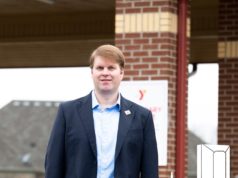by Dr. Nick Kouns
Last year, I had a meeting with Woodford Web, high atop the big blue building before the Courthouse Overlay District hearing that approved the demolition of the block. He, along with one of his vice-presidents (who, as I recall, was overseeing the proposed leasing of the space of the proposed building) had agreed to meet with me after I called them up right out of the blue about a contact that I thought they might want to connect with.
The House of Blues has a foundation whose mission statement reads as follows:
Mission Statement: The International House of Blues Foundation (IHOBF) is dedicated to bringing the arts to schools and communities through programs that increase public awareness of African American contributions to American culture.
Foundation programs explore the history, art and music of the blues and demonstrate the vast influence of the blues on contemporary music and culture. Programs draw upon the universal language of music and art to encourage creative expression and cultural understanding. The International House of Blues Foundation brings together people of diverse backgrounds in an atmosphere that encourages mutual respect and understanding.
Given that the Courthouse District is a geographical site rich in history, I thought this seemed like an idea that made sense. Although the ‘House of Blues’ is obviously a chain (originally founded by Kentuckian and Centre College graduate, Isaac Tigrett, before selling it to the multinational conglomerate, LiveNation), the House of Blues showcases local artists, as well as internationally renowned acts. Their Foundation is known for supporting the communities in which they do business, integrating almost seamlessly into the local fabric. I had some connections at LiveNation, and made a few phone calls. I ended up speaking with Chris Adelman who, in turn, put me into contact with Aidan Scully, their director of new markets and brand development. I had explained the proposed project, and the site’s history of once having served as the largest slave market in the south:
‘During the dark era of slavery in Kentucky, the section of town in Lexington known as ‘cheapside’ became the largest slave-trading locality in the state. In fact, the area was one of the most well known of the slave market districts in the South. Africans were beaten and families were separated forever as they were auctioned and sold in the courtyard. According to historical narratives, President Abraham Lincoln once observed the selling of slaves at this site. In the post-war period, ‘cheapside’ served as a public square and a market. (reprinted from visitlex.com)
While Woodford and the VP who was in charge of the leasing seemed incredibly interested in pursuing the connection, I attempted to impress upon them the importance of consulting local arts leaders, civic groups, and preservation advocates. I remember saying, ‘You know, lots of people have some really great ideas that could work to everyone’s advantage.This House of Blues thing is just one of them.’
The emails I have are all dated April, 2008. I have excerpted one of them below from Chris Adelman, who ultimately put me in contact with Aidan Scully, LiveNation’s House of Blues Brand Development/New Market guy:
‘…As discussed, I believe that Lexington will not fall within the required population, convention business,etc that the HOB looks for, typically the top 25 DMAs in the US, even if your city would be willing to pay for all the necessary construction.
That said, we are happy to give it a review and, even see if a non-HOB club would make sense. Would you be so kind as to send on to Aidan Scully SVP Development, your original email explaining the project…’
At this point, I signed off, forwarded the emails along, and bowed out. The next thing I knew, I was reading about The House of Blues’ ‘interest’ in pursuing possible expansion into the Lexington area. This was somewhat contrary to what I had been told directly by LiveNation. There was some initial interest in locating a Fillmore Club (a sort of ‘House of Blues lite’), but I wasn’t privy to those discussions. My most recent conversation with Woodford was at the Council Chambers on 05/05/2009. As it turned out, he was sitting right in front of me. I leaned forward, and asked him if he’d ever heard anything more from the House of Blues, or LiveNation. He said that he hadn’t heard anything at all from them since the economy started tanking.
How incredibly unfortunate. I still think this could have been a win/win. Given the rich history of Cheapside and the Courthouse Overlay Disctrict AND the House of Blues’ commitment to the African-American arts and music culture, this collaboration could have been, I believe, something meaningful. Would it have made up for the demolition of the block? No. Would it excuse any of the previous (and subsequent) acts of subterfuge and misdirection? No.Could it have been something important and meaningful for the city? I believe so.
I bring it up in the hope and belief that it is still not to late to allow some input on this project from the city. This affiliation came from a regular-joe citizen like me.
And I can’t help believe that there are SCORES of people with equally good or better ideas—ideas that are commercially viable, culturally significant, and artistically meaningful to our community. I keep thinking that surely, we can find common ground.
We are all Lexingtonians. We all share the same rich history.







